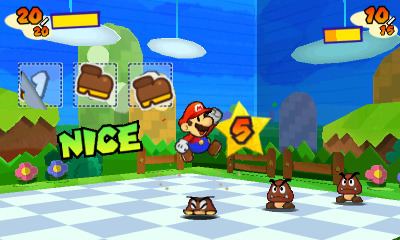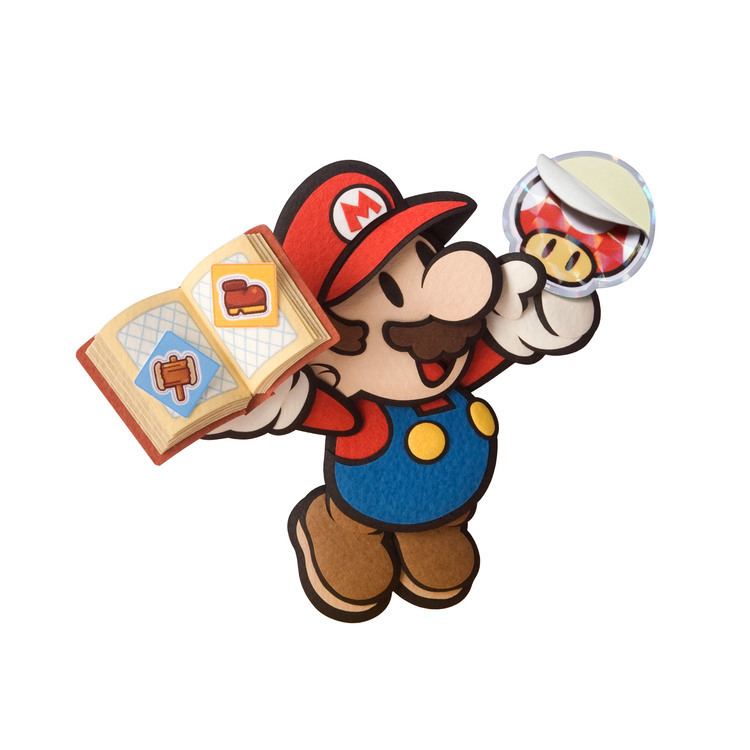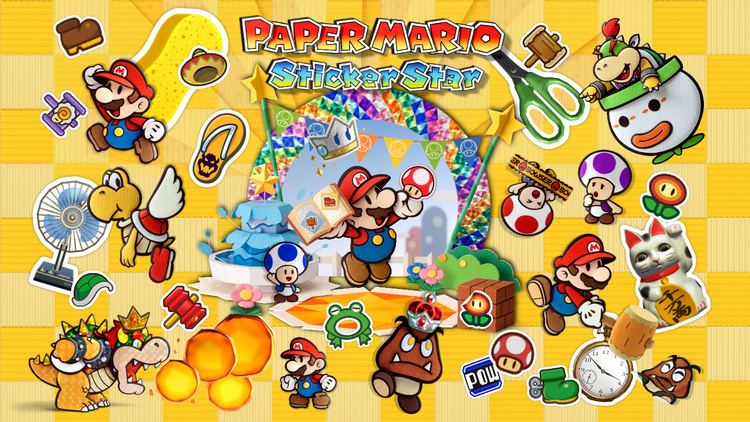7.8 /10 1 Votes7.8
75% Metacritic Programmer(s) Junya Kadono Genre Role-playing video game | 8.3/10 IGN 75% GameFAQs Initial release date 11 November 2012 | |||||||||||||||||||||||||||||||||
 | ||||||||||||||||||||||||||||||||||
Director(s) Naohiko AoyamaTaro Kudo Producer(s) Kensuke TanabeToshiyuki Nakamura Designer(s) Yukio MorimotoToshitaka Muramatsu Similar Nintendo games, Role-playing video games | ||||||||||||||||||||||||||||||||||
Paper Mario: Sticker Star, known in Japan as Paper Mario: Super Seal (ペーパーマリオスーパーシール, Pēpā Mario Sūpā Shīru), is a 2012 role-playing video game developed by Intelligent Systems and published by Nintendo for the Nintendo 3DS console. It is the fourth installment of the Paper Mario series and is the first game in the series playable on a handheld console. The game was released in North America on November 11, 2012 and in December 2012 in Japan, Europe and Australia.
Contents

Unlike the previous Paper Mario games, Sticker Star uses a papercraft visual style that is also heavily incorporated into its gameplay mechanics. Sticker Star introduces the use of stickers, which are littered throughout the game world and are used as items or power-ups, aiding the player in turn-based battles against enemies or in solving puzzles. The plot follows Paper Mario's quest to gather the 6 Royal Stickers that were scattered by Paper Bowser.

Paper mario sticker star part 2
Gameplay

Sticker Star features a visual style similar to its predecessors, in which the characters appear as paper cutouts in a 3D papercraft Mushroom Kingdom, with landscapes ranging from snowy areas and forests to volcanoes. The story focuses on Paper Mario's efforts to retrieve the 6 Royal Stickers that have been scattered by Paper Bowser after he attacked the annual Sticker Fest. Paper Mario is accompanied by Kersti, a sticker fairy, who bestows upon Paper Mario the power of stickers.

The player controls Paper Mario as he explores the various locales of the Paper Mushroom Kingdom. A major facet of Sticker Star's gameplay is the extensive use of collectible stickers, which are used to gain new abilities and progress through the game. The player collects stickers that are found and peeled off from various areas in the environment. The player can also purchase stickers using paper coins or receive them from non-playable characters. The player has limited inventory space, and larger stickers take up more room. Stickers are used both in combat and for interacting with the environment. The player can enter a state called "Paperization" that allows him to place stickers in certain areas of the visible overworld to activate certain events. The player can also find real-world objects, known in-game as "Things", such as baseball bats and scissors, that can be turned into special types of stickers, called "Thing Stickers", which are often needed to solve puzzles in the overworld. For example, a Fan Thing Sticker can be placed in strategic areas in the environment and, when activated, creates wind that moves or destroys obstacles.
The turn-based battles in Sticker Star are similar to those in the original Paper Mario game and The Thousand-Year Door, initiated when Paper Mario comes into contact with enemies in the overworld. The player's available attacks are determined by the stickers currently on hand. For example, possession of the Jump sticker is required for Paper Mario to attack an enemy by jumping on it. Certain kinds of attacks are required depending on the enemy being fought. For example: an enemy wearing a spiked helmet cannot be jumped on and must instead be attacked using a different kind of sticker, like a hammer. Thing Stickers are used to inflict more damage on enemies, and certain types of Thing Stickers are required to make it easier to defeat boss characters. However, each sticker is removed from play after one use; it is necessary for the player to consistently collect new stickers. Unlike the previous 3 games, the player increases his maximum HP and other stats through collection of HP hearts, which give him 5 more heath points and a stronger first attack, instead of gaining experience awarded from winning battles. Bonuses or special events that occur during battles can increase Paper Mario's attack power or allow him to use a single sticker multiple times.
Plot
Every year, the Sticker Comet lands in the Mushroom Kingdom, and those who wish on it have a good chance of their wish being granted by the Royal Stickers that reside within the comet. Mario attends the Sticker Fest, a festival held in Decalburg to accommodate the Sticker Comet's arrival; and Princess Peach presents the comet on the festival's stage.
As the Toad attendees begin to make their wishes, Bowser crashes the celebration and attempts to make his own wish by touching the comet. This causes the comet to explode, scattering the 6 Royal Stickers across the kingdom. One Royal Sticker lands on Bowser's head, corrupting him with its power. Bowser moves to kidnap Peach, but Mario intervenes. Bowser, strengthened by the power of the Royal Sticker, overcomes Mario, and knocks him out.
After regaining consciousness, Mario encounters Kersti the Sticker Fairy, caretaker of the Royal Stickers. Kersti then blames Mario for the touching of the Sticker Comet and does not believe Mario when he tells her it was Bowser's doing. Kersti demands that Mario help her recover the Royal Stickers, to which Mario willingly accepts. Together, the two embark on a journey to recover the Royal Stickers.
After traveling to plains, mountains, deserts, forests, beaches, icy peaks, jungles and volcanoes the duo reach Bowser's Sky Castle, defeating Kamek and Bowser Jr. along the way.
Mario and Kersti finally find Peach, but a battle against Bowser, who's still empowered with the Royal Sticker, soon ensues. Eventually, Mario pushes Bowser off a platform, only for Bowser to grow to gigantic proportions due to the Royal Sticker's power still being inside him. Kersti then realizes that her own sticker power is the only thing that can match Bowser's sticker power. Kersti then sacrifices herself by giving Mario all of her power, whilst apologizing for "forcing" him to go on the quest with her in the first place. With Kersti's power inside of him, Mario is able to defeat Bowser and save Peach. Peach then reminds Mario of the Royal Sticker's ability to grant wishes and asks Mario what his wish is.
Mario and Peach arrive back in Decalburg to once again present the Sticker Comet. Bowser then once again attempts to touch the comet, but just before he touches it, Kersti pops out and stops him, revealing that Kersti was revived by Mario's wish. Kersti then states that if Sticker Fest is to be this way every year, she would need to reconsider her career.
Development
According to an interview with some of the game's developers, the partner system prevalent in previous Paper Mario titles was removed because it was found to often conflict with the sticker-focused gameplay and the developers were asked by Miyamoto to make a Paper Mario game only using traditional characters as much as possible and "stop creating and introducing new characters," which also had the consequence of removing the partner system. Miyamoto also asked the developers to change the gameplay and battles because he considered it to be too similar to The Thousand Year Door and asked the developers to greatly de-emphasise the game's story, saying "It's fine without a story, so do we really need one?" The world map and level system seen in Sticker Star was implemented so that players could easily stop and resume play at any time.
One of the major motivations for the development team after Miyamoto insisted on no story (or at the very least, minimal story) was to survey Club Nintendo members to see if they liked the story in the previous games. Not even 1% responded that they liked the story, and the response generated led the team to moving in more of the emphasis on paper.
Paper Mario: Sticker Star was first announced at E3 2010 under the tentative title Paper Mario, demonstrated in trailer form. Few details about the new Paper Mario title were given outside of additional trailers that were released at Nintendo World 2011 and E3 2011. The game and its full title was announced during Nintendo's E3 2012 press conference, alongside New Super Mario Bros. 2 and Luigi's Mansion: Dark Moon, with a release window sometime during the 2012 holiday season. A live gameplay demonstration by Nintendo of America localization manager Nate Bihldorff, one of the writers for Sticker Star's English text, was later shown at the Nintendo 3DS Showcase event, which heavily detailed and elaborated on the sticker-focused gameplay. The game was also announced to be distributed both physically as a Nintendo 3DS cartridge or downloadable via Nintendo eShop.
Reception
Sticker Star received mixed to positive reviews, gaining aggregate scores of 75.97% and 75% from GameRankings and Metacritic, respectively. These are the lowest scores of any game in the Paper Mario series.
Ben Lee of Digital Spy gave the game 3 out of 5 stars, praising the visuals, but commented on the game's difficulty and backtracking. "Writing is sharp and legitimately funny at times. [The game] has a lot of charm and personality [but] stalls horribly as you backtrack and replay level after level, trying to figure out what you're missing. It's often unclear where Mario needs to go to progress, and these moments end up being frustrating and ruin the flow of the story."
The Academy of Interactive Arts & Sciences chose Sticker Star as the "Best Handheld Game of the Year" during their 16th Annual D.I.C.E. Awards ceremony.
The game sold 402,000 copies in Japan in 2012. As of March 31, 2013, the game has 1,970,000 worldwide sales.
